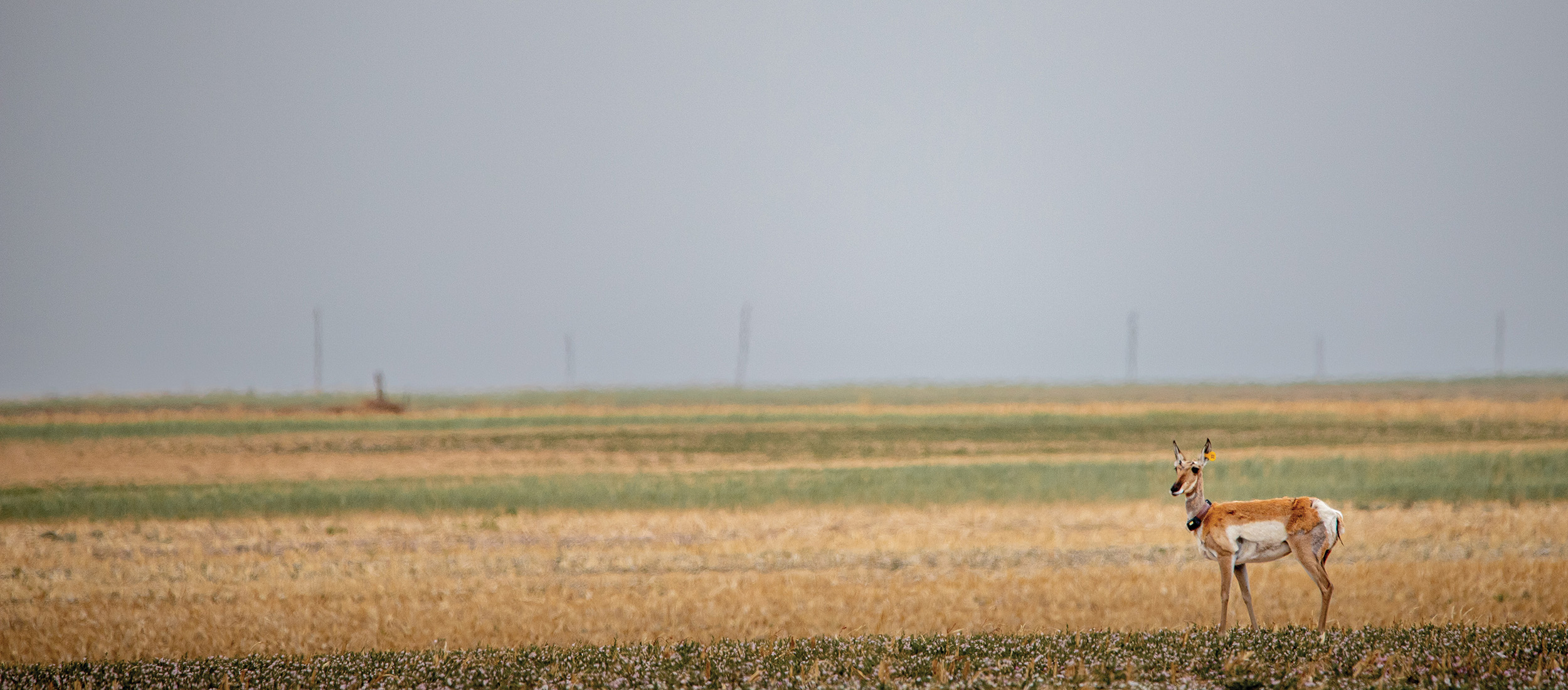
Preserving the Pronghorn
Monday, January 9, 2023
Media Contact: Kaitlyn Weldon | Digital Communications Specialist | 405-744-7063 | kaitlyn.weldon@okstate.edu
The orange sun sets over the horizon as a mother pronghorn antelope and her fawn seek shelter for the night across the plains of northwestern Oklahoma. Their future is unknown as they trudge forward, just trying to survive.
With a sudden decrease in pronghorn population, Oklahoma State University Department of Natural Resource Ecology and Management faculty and graduate students conducted pronghorn mother and fawn research. This past spring, the researchers partnered with Texas A&M-Kingsville and East Central University of Oklahoma.
“This project originated because the Oklahoma Department of Wildlife Conservation was starting to see a trend toward potential population decline of pronghorn in the Panhandle,” said Colter Chitwood, an assistant professor in the OSU NREM department. “They wanted to double check to see if this decline was as accurate as they perceived and what the reasons for the decline were.”
This project was made possible through the $1.7 million ODWC-funded grant called “Movements and Population Demography of Pronghorn in Western Oklahoma.”
The grant for this project is across four pronghorn capture years, beginning in January 2022 and ending in summer 2026. The project will tag adults in the winter and then fawns in May and June.
After the implementation of the grant in January 2022, 81 females and 20 males were captured using a helicopter in February 2022.
The process to capture pronghorn for tracking is out of the ordinary, as a small helicopter flies above a herd and a net is fired over them to trap them.
“There is a pilot, a mugger and a gunner,” said Derek Hahn, an NREM master’s student. “The gunner hangs outside the aircraft with a long-barrel pistol and a cone with a weighted net on the back. Then, they fly over the herd of pronghorn, shoot the net, and try to capture one animal at a time. After being captured, each animal receives a GPS collar.”
This process continues until all pronghorn females and males have received tracking collars. For fawns, capture is done on foot by waiting until a fawn is spotted and placing a long-handled net over them.
“It’s almost like a cradle-to-grave assessment,” said Matthew Turnley, an NREM doctoral student. “We try and put tracking collars on as many newborns as possible.
“We also put tracking collars on adults,” he said. “We can use that information to follow them throughout their lives and to see how they are surviving, if they are dying, what the cause of the mortality is, and where and whenthey are moving.”
The project’s focus is on population parameters with varying ages. Older pronghorn sometimes move out of the state, often into New Mexico, Chitwood said.
“With changing agricultural practices and land ownership as well as potential increases with things like wind energy, Oklahoma and other states are really interested in how pronghorn respond,” Turnley said. “The GPS collars give us all kinds of movement and survival information.”
Research is centered on survival rate and if a possibility exists to keep numbers stable or increase, Chitwood said. With lots of variability in the western plains system, a drought, rain, a temperature swing and more can affect fawn survival.
The beginning steps of this project involve energetics and nutrient levels, moving toward population modeling during the next three years to result in a better species management program, Hahn said.
With this project recently starting, researchers have a lot of hope and excitement moving forward because this is the first time pronghorn have been collared in Oklahoma, Hahn said.
With the continuous movement of pronghorn, private landowner communication has become a priority with this project.
Their contribution has been a positive thing for the research, as staff for this project are respectful of private property rights and make sure to work with these landowners, he said.
“An important thing to realize is that there is not a lot of public land in Oklahoma and none of the research would be possible without help from private landowners,” Hahn said.
Researchers work with these landowners to cover more land for tracking and more exposure to pronghorn. With little public land, a need for access to private land exists and landowners have been supportive of the research and of OSU.
“Wildlife are everywhere and belong to everyone,” Chitwood said. “With private land, when an agency is trying to better manage something like pronghorn, which matter to hunters because they want to harvest them, it is certainly in everyone’s best interest. At the end of the day, neither the hunters nor wildlife watchers want them to leave the Panhandle.”
Research is conducted in Texas and Cimarron counties. Moving farther east across the Panhandle, pronghorn are spotted less often.
“I just want to see people enjoy the pronghorn and their fawns as much as I do,” Hahn said. “Western Oklahoma is a good destination for them. Everyone goes out there for the Black Mesa State Park.
“There is great wildlife viewing out there,” he added. “It offers a good chance to get away.”
Oklahomans from the Panhandle have a sense of pride when talking about pronghorn, Hahn said. The public needs information about this species to see how impactful they are to Oklahoma terrain.
“We look at this Great Plains ecosystem, which has seen so much change over time,” Turnley said. “Pronghorn have survived an Ice Age and so much before that. They are this last remnant of the American Great Plains and that is beneficial.”
Story By: Megan Fragasso | Cowboy Journal
